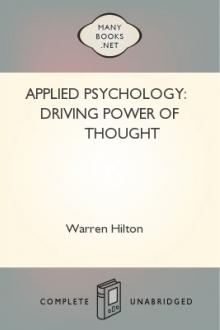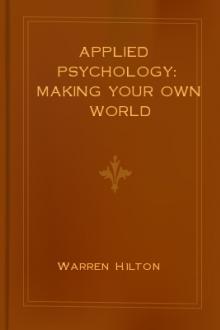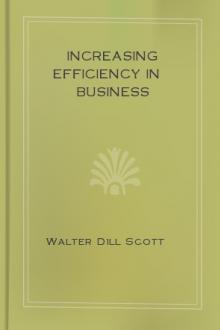Applied Psychology: Driving Power of Thought, Warren Hilton [each kindness read aloud .TXT] 📗

- Author: Warren Hilton
- Performer: -
Book online «Applied Psychology: Driving Power of Thought, Warren Hilton [each kindness read aloud .TXT] 📗». Author Warren Hilton
A large number of tests and mechanical devices, some of them most complicated, have been scientifically formulated or invented to measure the quickness of different kinds of mental operations in the individual.
One very simple test which we give merely to illustrate the principle is called the "Test of Uncontrolled Association." All the materials needed for this test are a stop-watch and a blank form containing numbered spaces for one hundred words.
Give these instructions to the person you are examining: "When I say 'Now!' I want you to start in with some word, any one you like, and keep on saying words as fast as you can until you have given a hundred different words. You may give any words you like, but they must not be in sentences. I will tell you when to stop." You then start your stop-watch with the command "Now!" and write the words on the blank form as fast as they are spoken. Mere abbreviations or shorthand will suffice. When the hundredth word is reached, stop the watch and note the time.
The average time for lists of words written in this fashion is about 308 seconds.
This is a fair test of the rapidity of the associative processes of the mind. It will reveal many strange and characteristic idiosyncrasies. On the other hand, considering the vast number of words available, it is remarkable to note the degree of community to be found in the words that will be given by a number of persons. Thus, "in fifty lists (5,000 words) only 2,024 words were different, only 1,266 occurred but once, while the one hundred most frequent words made up three-tenths of the whole number."
Professor Jastrow, of Wisconsin University, has found also that the "class to which women contribute most largely is that of articles of dress, one word in every eleven belonging to this class. The inference from this, that dress is the predominant category of the feminine (or of the privy feminine) mind, is valid, with proper reservations."
Another method of testing speed of thought is to pronounce a series of words and after each word have the subject speak the first word that comes to him. The answers are taken down and are timed with a stop-watch. About the quickest answers by an alert person will be made in one second, or one and one-fifth seconds, while most persons take from one and three-fifths to two and three-fifths seconds to answer, under the most favorable circumstances. Puzzling words or conflicting emotions will prolong this time to five and ten seconds in many cases. Much depends upon the kind of words propounded to the subject, starting with such simple words as "hat" and "coat," and changing to words that tend to arouse emotion. A list of words may be carefully selected to fit the requirements of different classes of subjects.
By appropriate tests, the quickness of response to sense-impressions, the character of the associations of ideas, the workings of the individual imagination, the nature of the emotional tendencies, the character and scope of the powers of attention and discrimination, the degree of persistence of the individual and his susceptibility to fatigue in certain forms of effort, the visual, auditory and manual skill, and even the moral character of the subject, can be more or less clearly and definitely determined.
It is possible by these tests to distinguish individual differences in thought processes as conditioned by age, sex, training, physical condition, and so on, to analyze the comparative mental efficiency of the worker at different periods in the day's work as affected by long hours of application, by monotony and variety of occupation and the like, and even to reveal obscure mental tendencies and to disclose motives or information that are being intentionally concealed.
Among the simplest of such tests are those for vision, hearing and color discrimination. Tests of this kind are now given to all applicants for enlistment in the army, the navy and the marine corps, and more exacting tests of the same sort are given to candidates for licenses as pilots and for positions as officers of ships.
Employees of railroads, and in some cases those of street railroads, also, are subjected to tests for vision, hearing and color-discrimination. In the case of trainmen the color-discrimination tests result in the rejection of about four per cent of the applicants. The tests are repeated every two years for all the men and at intervals of six months for those suspected of defects in color discrimination. In all of these cases the tests have for their object the detection and rejection of unfit applicants.
One of the earliest instances of work of this kind was the introduction a few years ago of reaction-time tests in selecting girls for the work of inspecting for flaws the steel balls used in ball bearings. This work requires a concentrated type of attention, good visual acuity and quick and keen perception, accompanied by quick responsive action. The scientific investigator went into a bicycle ball factory and with a stop-watch measured the reaction-time of all the girls then at work. All those who showed a long time between stimulus and reaction-time were then eliminated. The final outcome was that thirty-five girls did the work formerly done by one hundred and twenty; the accuracy of the work was increased by sixty-six per cent; the wages of the girls were doubled; the working day was shortened from ten and one-half hours to eight and one-half hours; and the profit of the factory was substantially increased.
To illustrate the methods employed and the importance of work of this kind, we quote the following from the recent ground-breaking book, "Psychology and Industrial Efficiency," by Professor Hugo Münsterberg, of Harvard University. This extract is an account of Professor Münsterberg's experimental method for determining in advance the mental fitness of persons applying for positions as telephone operators. Such information would be of immense value to telephone companies, as each candidate who satisfies formal entrance requirements receives several months' training in a telephone school and is paid a salary while she is being trained.
One company alone employs twenty-three thousand operators, and more than one-third of those employed and trained at the company's expense prove unfitted and leave within six months, with a heavy resulting financial loss to the company. The tests are numerous and somewhat complicated and require more time to conduct them than tests in other lines of work, but for these very reasons will be particularly illuminating. Professor Münsterberg says:
"After carefully observing the service in the central office for a while, I came to the conviction that it would not be appropriate here to reproduce the activity at the switchboard in the experiment, but that it would be more desirable to resolve that whole function into its elements and to undertake the experimental test of a whole series of elementary mental dispositions. Every one of these mental acts can then be examined according to well-known laboratory methods without giving to the experiments any direct relation to the characteristic telephone operation as such. I carried on the first series of experiments with about thirty young women who a short time before had entered into the telephone training-school, where they are admitted only at the age between seventeen and twenty-three years. I examined them with reference to eight different psychological functions. * * * A part of the psychological tests were carried on in individual examinations, but the greater part with the whole class together.
"These common tests referred to memory, attention, intelligence, exactitude and rapidity. I may characterize the experiments in a few words. The memory examination consisted of reading the whole class at first two numbers of four digits, then two of five digits, then two of six digits, and so on up to figures of twelve digits, and demanding that they be written down as soon as a signal was given. The experiments on attention, which in this case of the telephone operators seemed to me especially significant, made use of a method the principle of which has frequently been applied in the experimental psychology of individual differences, and which I adjusted to our special needs. The requirement is to cross out a particular letter in a connected text. Every one of the thirty women in the classroom received the same first page of a newspaper of that morning. I emphasize that it was a new paper, as the newness of the content was to secure the desired distraction of the attention. As soon as the signal was given, each one of the girls had to cross out with a pencil every 'a' in the text for six minutes. After a certain time, a bell signal was given, and each then had to begin a new column. In this way we could find out, first, how many letters were correctly crossed out in those six minutes; secondly, how many letters were overlooked; and thirdly, how the recognition and the oversight were distributed in the various parts of the text. In every one of these three directions strong individual differences were indeed noticeable. Some persons crossed out many, but also overlooked many; others overlooked hardly any of the 'a's,' but proceeded very slowly, so that the total number of the crossed-out letters was small. Moreover, it was found that some at first do poor work, but soon reach a point at which their attention remains on a high level; others begin with a relatively high achievement, but after a short time their attention flags, and the number of crossed-out letters becomes smaller or the number of unnoticed, overlooked letters increases. Fluctuations of attention, deficiencies and strong points can be discovered in much detail.
"The third test, which was tried with the whole class, referred to the intelligence of the individuals. * * * The psychological experiments carried on in the schoolroom have demonstrated that this ability can be tested by the measurement of some very simple mental activities. * * * Among the various proposed schemes for this purpose, the figures suggest that the most reliable one is the following method, the results of which show the highest agreement between the rank order based on the experiments and the rank order of the teachers. The experiment consists in reading to the pupils a long series of pairs of words of which the two members of the pair always logically belong together. Later, one word of each pair will be read to them and they have to write down the word which belonged with it in the pair." (For example, "thunder" and "lightning" are words that "logically belong together," while "horse" and "bricks" are unrelated terms.—Editor's note.)
"This





Comments (0)